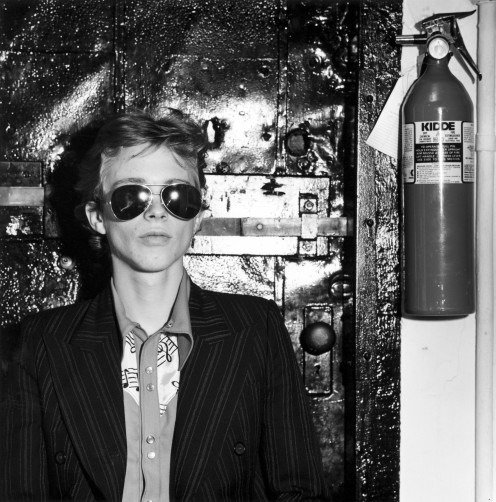Robert Mapplethorpe
dal 5/6/2013 al 19/7/2013
Segnalato da
5/6/2013
Robert Mapplethorpe
Xavier Hufkens, Bruxelles
Au Debut (works from 1970 to 1979). Mapplethorpe's prints representing portraits, nudes, flowers, and erotic and sadomasochistic subjects dominated photography in the late 20th century.

'I’m looking for the unexpected. I’m looking for the things I have never seen before.'
Robert Mapplethorpe
Xavier Hufkens is pleased to present an exhibition of the early work by
legendary American artist Robert Mapplethorpe in the new gallery space
in rue Saint Georges, Brussels.
This is a show that will enchant Mapplethorpe connoisseurs – through
the jewel like one off quality of the polaroid works and the chance to see
the earliest seeds of lifelong friendships in the silver gelatine prints. The
works equally introduce the novice to Mapplethorpe’s compelling and
compulsive oeuvre, marked by extremes of elegance and grace.
Mapplethorpe’s prints representing portraits, nudes, flowers, and erotic
and sadomasochistic subjects dominated photography in the late 20th
century. Less known are the Polaroid works that Mapplethorpe produced
in the early 1970s. This special exhibition traces Robert Mapplethorpe’s
use of instant photography from 1970 to 1975 and a selection of his early
silver gelatin prints The show brings together some hundred objects,
many never exhibited before. Included are self-portraits, figure studies,
still lifes, and portraits of lovers and close friends including Patti Smith,
Sam Wagstaff and John McKendry. Best-known for the highly stylized
and neoclassically inspired works he made between the late 1970s and his
death in 1989, Mapplethorpe’s mature work was in fact preceded by an
important but largely unknown body of photographs made with Polaroid
cameras between 1970 and 1975, when Mapplethorpe was in his twenties.
Many of these small, intimate polaroids in black and white like Eddie in
front of the fireplace, 1972 and Nicky Waymouth, 1973 convey tenderness
and vulnerability. Others depict a toughness and immediacy that would
give way in later years to more classical form. Unlike the highly crafted
images Mapplethorpe staged in the studio and became famous for, these
disarming pictures are marked by spontaneity and invention.
In the mid 70s, Mapplethorpe grew increasingly interested in
documenting the New York S&M scene. The resulting photographs
are shocking for their content and remarkable for their technical and
formal mastery. In Jim, Sausalito from 1977, the main character is clad in
leather boots, trousers and mask, all typical of the gay S&M scene. The
triangular shape formed by his body is bathed in light from above, as
his gloved hands hold on to the rungs of a ladder which forms a grid of
horizontals and verticals in the left half of the image. The man may look
menacing, but he seems attracted to the light above. Mapplethorpe was
constantly drawn to the ambiguous relationships between light and dark,
good and bad, heaven and hell. Yet Mapplethorpe's art always revealed
the humanity and emotions of his subjects behind their leather, spikes,
and chains. Mapplethorpe told ARTnews in late 1988, "I don't like the
particular word 'shocking.' I'm looking for the unexpected. I'm looking for
things I've never seen before ... I was in a position to take those pictures. I
felt an obligation to do them.
In 1976, Mapplethorpe took up a Hasselblad medium-format camera
given to him by Sam Wagstaff, the visionary curator who became his
benefactor and mentor. Mappelthorpe worked primarily in the studio and
began producing large-scale still lifes of subjects such as lilies, gladioli,
interiors, nudes, portraits and self-portraits. One of his earliest celebrity
portraits, Patti Smith (1975), was carefully staged by Mapplethorpe and
Smith, his lifelong friend. In this photograph, Smith broke radically from
the image that women in rock were expected to assume, and embodies
the androgyny often found in Mapplethorpe’s photographs. His portraits
of Smith capture her loneliness and her independence, her sensitivity and
her wildness. Around 1979 Mapplethorpe began to photograph black
men. As his biographer, Patricia Morrisroe, wrote, he found that “he could
extract a greater richness from the colour of their skin”, in particular the
tonal range between the highlights and the shadows was more dramatic.
In the close-up Bob Love, 1979 Mapplethorpe exploits the contrast
between the highlights on his shoulder and face and the inky darkness of
his neck and the back and top of his head.
Robert Mapplethorpe was born in Floral Park, Queens, USA, in 1946 in
New York. He earned a B.F.A. from Pratt Institute in Brooklyn, where
he produced artwork in a variety of media, mainly collage. The shift
to photography as Mapplethorpe’s sole means of expression happened
gradually during the mid-1970s. He took his first photographs using a
Polaroid camera, and later became known for his portraits of artists,
architects, socialites, stars of pornographic films, members of the S&M
community, and an array of other unique people, many of whom were
personal friends. During the early 1980s, his photographs shifted to
emphasize classical formal beauty, concentrating on statuesque male and
female nudes, flowers, still lifes, and formal portraits. Mapplethorpe died
in Boston in 1989.
We are immensely grateful for all the help we have received in organizing
this exhibition from the Mapplethorpe Foundation, with a very special
thanks due to Monica Eulitz.
Private View, Thursday, 6 June, 5–8pm
Xavier Hufkens
6—8 rue St-Georges | St-Jorisstraat - 1050 Brussels, Belgium
Open Tuesday to Saturday, 11 am to 6 pm



